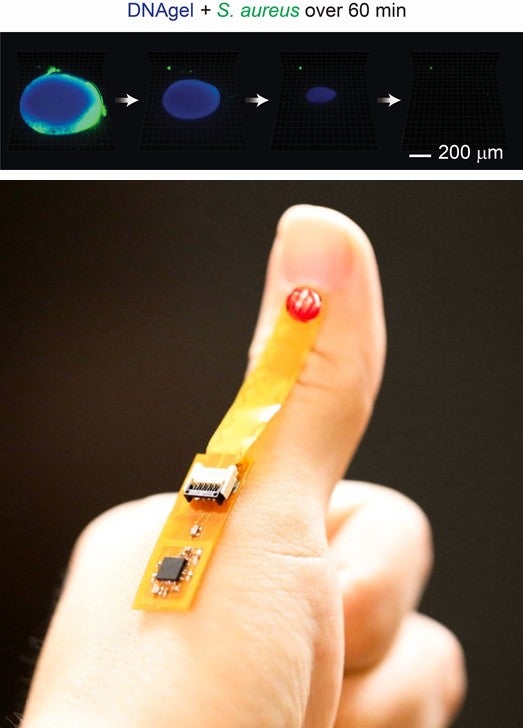Wireless sensing of secreted enzymes from wound pathogens
March 16, 2022NUS researchers have developed a DNA hydrogel-based sensor that can sit under bandages and identify infections in open wounds before visible signs are present.
Healthy human skin hosts a diverse microbial community. Some of these microbes, such as Staphylococcus aureus (S. aureus), are opportunistic pathogens that can colonise an open wound when the skin barrier is breached. Healthcare practitioners typically identify infections through clinical observation and further confirmation of infection is done using a microbe culture test. However, observations are subjective and culture tests take time — both require that a patient is physically present in the hospital or outpatient clinic.
A research team comprising Assistant Professor LI Hao from the Department of Chemistry and Assistant Professor John S. HO from the Department of Electrical and Computer Engineering, National University of Singapore, has developed a new alert system (dubbed the “wireless infection detection on wounds” (WINDOW) sensor) based on a customised DNA hydrogel, known as DNAgel (see Figure). This jelly-like hydrogel remains stable under humid conditions such as that found on the skin. However, it begins to break down in the presence of an enzyme called deoxyribonuclease or DNase, which is secreted by various pathogenic bacteria such as S. aureus. The breakdown of DNAgel is sensed by a chip that broadcast the signal using a battery-free wireless approach called near-field communications (See Figure). This enables early detection of infection on the wound for potential intervention before there are visible signs. The team in collaboration with St Luke’s Hospital has successfully tested the DNAgel using wound swab cultures from 18 patients with diabetic foot ulcers. Real-time monitoring was also validated on murine models whose wounds were exposed to S. aureus.
Prof Li said, “Monitoring microbial virulence through secreted enzymes is an important aspect of wound care. Beyond DNases, this approach could be used to detect a variety of other microbial enzymes that are responsible for invading wound tissues during infection.”
Dr XIONG Ze, a research team member and the first author of the paper said, “Our work differs from previous wound sensors that detect changes in temperature, pH or electrical impedance. We achieve detection through sensing a clinical wound biomarker, DNase that is directly associated with infection using a DNA hydrogel material that selectively responds to it.”

Figure: (Top) Degradation of DNAgel after incubation with a pathogenic bacteria, S. aureus. (Bottom) The sensing technology, termed wireless infection detection on wounds (WINDOW) can be attached to the skin surface to detect an enzyme released by pathogenic bacteria at the site of the wound. [Credit: Science Advances, Xiong Ze]
Reference
Z Xiong*; S Achavananthadith; S Lian; LE Madden; ZX Ong; W Chua; V Kalidasan; Z Li; Z Liu; P Singh; H Yang; SP Heussler; SMP Kalaiselvi; MBH Breese; H Yao; Y Gao; K Sanmugam; BCK Tee; P-Y Chen; W Loke; CT Lim; GSH Chiang; BY Tan; H Li; DL Becker; JS Ho*, “A wireless and battery-free wound infection sensor based on DNA hydrogel” SCIENCE ADVANCES Volume: 7 Issue: 47 Article Number: eabj1617 DOI: 10.1126/sciadv.abj1617 Published: 2021.


